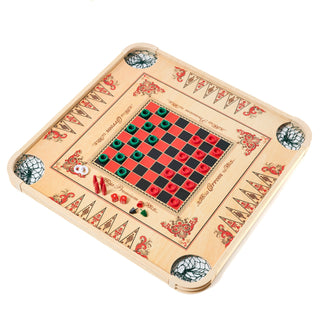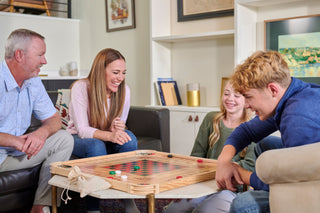This article discusses how to use a 4 team single elimination bracket to hold a tournament. Begin by right-clicking on the image below and selecting “Save Image As” or simply download the PDF version for easy printing. Keep reading to learn how it works.

What is a 4-Team Single Elimination Bracket?
A 4-team single elimination bracket is a scoresheet used to keep track of a small tournament. In single elimination matches, teams compete in a series of games where the loser of each match is immediately eliminated. The winners of each game progress to the next round, and the tournament continues until a single champion emerges.
Using the Downloadable Bracket
The bracket is divided into two rounds: the semifinals (Games 1 & 2) and the final (Game 3). The four teams are paired into two initial matchups, with the winners advancing to the championship round. Keep in mind that the losers of the semifinals are eliminated. We offer some suggestions below for handling that aspect of the game with grace.
-
Semifinals (Games 1 & 2): Write the names of the teams competing against one another in the brackets for games 1 & 2 on the sheet. Scroll down for tips about matching teams. Note the scores of each game if you wish.
-
Finals (Game 3): Note the winners of the semifinals in the two brackets called “Game [1] Winner” and “Game [2] Winner” before they face off to determine the champion. After the final game, note the winner of the tournament prominently on the sheet.
Scheduling Matches
Scheduling for a 4-team single elimination tournament is quick and easy. Two matches are played in the first round (semifinals), followed by a break or rest period, and then the final match. It’s important to allow time between rounds for recovery and preparation, especially if the matches are physically or mentally demanding.
What Happens in the First Round?
In the first round of a small tournament that has an even number of teams, all the teams are paired into matchups. These early matches are often the most fast-paced and unpredictable as all teams are involved.
If you’re playing on a Nok Hockey board, you can hold the games consecutively. This has the added advantage of building in more rest time for teams. Of course, if you have more than one board, you can play as many games as you are able at the same time.
What Happens in the Final Round?
In the final round of any single elimination tournament, there are only two remaining teams. This match determines the tournament champion. If desired, a consolation match can be organized for the two losing teams from the first round to compete for third place.
Different Ways to Draw
A "draw" refers to the method used to determine how teams or participants are placed into the tournament bracket.
Blind or Random Draw
Blind (aka Random) draws involve assigning teams to their bracket positions randomly. There are many ways to draw randomly, including using free tools online. Search “free random name picker” for a variety of options. Additionally, you can assign each team a number and then draw those numbers from a hat or bucket to make blind selections.
This method is simple and adds an element of unpredictability to the tournament, but it does not take into account skill level, which can sometimes impact the fairness of the outcome.
Seeded Draw
In a seeded draw, teams are ranked based on skill, age, or past performance, and placements are designed to prevent the strongest teams from meeting in early rounds. Teams are assigned a “seed” (a number that designates their strength), and then paired so that the top two teams are not assigned together. This can be ideal with mixed-age groups and family settings where adults might have an advantage over younger children.
Randomized but Balanced
Teams are drawn randomly, but adjustments are made to avoid early matchups between the strongest participants. This method balances fairness with excitement.
How to Handle Tiebreakers
Tiebreakers can occur in tightly contested matches, and it’s a good idea to establish clear rules beforehand. Having a plan in place helps avoid disputes later on. To resolve a tie, you can try one of the following methods:
-
Extra Time: Adding additional playtime to break the tie.
-
Sudden Death: The tied teams face off, and the first team to score or achieve a point wins.
-
Skill Challenge: Similar to sudden death, this type of tiebreaker involves setting up a specific skill-based competition, such as a penalty shootout or face-off.
Dealing with Eliminations Gracefully
Losing is an inherent part of single elimination tournaments. It’s important to handle eliminations in a way that maintains a sense of good will. Make sure to celebrate participation by appreciating and acknowledging the efforts of eliminated teams. You may also choose to offer consolation matches, which means allowing eliminated teams to play additional matches for placement. Finally, sharing performance highlights can keep morale high and encourage future participation.
Using Single Elimination Brackets for Nok Hockey Tournaments
Single elimination brackets are a great fit for Nok Hockey tournaments, especially within families and friend groups. Tournaments encourage longer play that’s both intense and engaging. It also allows you to involve a larger number of people regardless of how many Nok Hockey tables you have.
Single elimination Nok Hockey tournaments create exciting competition within larger group settings, such as birthdays, family gatherings, and holidays. Using seeded draw means you can compensate for different skill levels as well, making competitive play possible amongst mixed-age groups.
Learn how to play Nok Hockey, Skittles, or Carrom by clicking one of the links!
All Tournament Brackets for Download
- 5 Team Single Elimination Bracket
- 6 Team Single Elimination Bracket
- 7 Team Single Elimination Bracket
- 8 Team Single Elimination Bracket
- 9 Team Single Elimination Bracket
- 10 Team Single Elimination Bracket
- 11 Team Single Elimination Bracket
- 12 Team Single Elimination Bracket
- 14 Team Single Elimination Bracket
- 15 Team Single Elimination Bracket
- 16 Team Single Elimination Bracket

